Tulasi dosages: 60 caps
Tulasi packs: 1 bottles, 2 bottles, 3 bottles, 6 bottles

Order discount tulasi on-line
The proper and left hepatic ducts also be a part of in the porta to form the widespread hepatic duct. The determine on left reveals functional divisions of the lobule into three zones shown by circles. The determine on proper exhibits hepatic sinusoid perisinusoidal area and cords of hepatocytes. Manufacture of a quantity of main plasma proteins similar to albumin, fibrinogen and prothrombin. Thus a battery of liver function checks is employed for correct diagnosis, to assess the severity of harm, to judge prognosis and to consider remedy. The unconjugated bilirubin degree is then estimated by subtracting direct bilirubin worth from this whole value. Clay-coloured stool due to absence of faecal excretion of the pigment signifies obstructive jaundice. Hepatobiliary ailments with cholestasis are associated with raised levels of serum bile acids which are responsible for producing itching (pruritus). Most of the conventional serum alkaline phosphatase (range 33-96 U/L) is derived from bone. In the absence of bone disease and pregnancy, an elevated serum alkaline phosphatase ranges typically replicate hepatobiliary illness. Very excessive levels are seen in intensive acute hepatic necrosis such as in severe viral hepatitis and acute cholestasis. Alcoholic liver disease and cirrhosis are associated with delicate to reasonable elevation of transaminases. A number of plasma proteins and immunoglobulins are synthesised on polyribosomes certain to the rough endoplasmic reticulum inside the hepatocytes and discharged into plasma. Hyperglobulinaemia could also be present in chronic inflammatory issues similar to in cirrhosis and chronic hepatitis. Prothrombin time depends upon both hepatic synthesis of clotting factors and intestinal uptake of vitamin K, a fatsoluble vitamin. The rise in serum ammonia is due to lack of ability of severely damaged liver to convert ammonia to urea. Blood lipids Estimations of complete serum cholesterol, triglycerides and lipoprotein fractions are frequently carried out in patients with liver disease. Values are lowered in acute and persistent diffuse liver diseases and in malnutrition. Both these checks are accomplished after evaluation of signs of obstruction since these exams are contraindicated in cholestasis. Blood tests for manufacture of proteins, lipids and carbohydrates are routinely done. Bilirubin pigment has high affinity for elastic tissue and hence jaundice is especially noticeable in tissues rich in elastin content. Jaundice turns into clinically evident when the entire serum bilirubin exceeds 2 mg/dl. A rise of serum bilirubin between the traditional and 2 mg/dl is usually not accompanied by seen jaundice and is known as latent jaundice. Conjugated bilirubin is certain to albumin in two types: reversible and irreversible. Besides, it additionally occurs in poisoning with chloroform, carbon tetrachloride and sure medication. However, hyperbilirubinaemia as a outcome of first three mechanisms is principally unconjugated while the last variety yields primarily conjugated hyperbilirubinaemia. Hence, at present pathophysiologic classification of jaundice relies on predominance of the sort of hyperbilirubinaemia. The presence of bilirubin in the urine is evidence of conjugated hyperbilirubinaemia. Extrahepatic cholestasis (Extrahepatic biliary obstruction) Mechanical obstruction. Predominantly Unconjugated Hyperbilirubinaemia this form of jaundice may result from the next three sets of situations: 1.
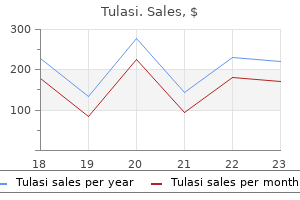
Cheap tulasi 60 caps online
About 90% of the tumours are papillary (non-invasive or invasive), whereas the remaining 10% are flat indurated (non-invasive or invasive). More common places for either of the 2 types are the trigone, the area of ureteral orifices and on the lateral walls. Exophytic papillomas are generally small, less than 2 cm in diameter, having delicate papillae. Thus, epithelial tumours are the main tumours, overwhelming majority of which are of transitional cell kind (urothelial) tumours (Table 20. Most of the cases seem past 5th decade of life with 3-times greater preponderance in males than females. Industrial occupations Workers in industries that produce aniline dyes, rubber, plastic, textiles, and cable have excessive incidence of bladder cancer. Bladder cancer could occur in workers in these factories after a protracted publicity of about 20 years. Schistosomiasis There is elevated risk of bladder most cancers, particularly squamous cell carcinoma, in sufferers having bilharzial infestation (Schistosoma haematobium) of the bladder. It is believed to induce local irritant impact and initiate squamous metaplasia followed by squamous cell carcinoma. Systemic Pathology looking transitional cells having regular number of layers (upto 6-7) in thickness. Patients of exophytic papillomas could sometimes develop recurrences and require long-term observe up. These flat lesions have cytologic features much like high-grade urothelial carcinoma similar to lack of cohesiveness, nuclear pleomorphism, and mitoses. Papillary urothelial carcinoma, high grade: Highgrade tumours have elevated thickness and have fused and branching papillae which present fairly disorderly arrangement. Invasive urothelial carcinoma Any grade of papillary urothelial carcinoma may present invasion into lamina propria or further into muscularis propria (detrusor). Association of squamous carcinoma and schistosomiasis has already been highlighted. The tumour is characterised by glandular and tubular sample with or without mucus production. Small cell carcinoma this variant has morphologic resemblance with small cell carcinoma of the lung or different neuroendocrine carcinomas and has a worse end result. Mixed carcinoma Occasionally, combination of a couple of histologic varieties are seen. It exists in 2 types: Adult form occurring in adults over forty years of age and resembles the rhabdomyosarcoma of skeletal muscle. Childhood kind occurring in infancy and childhood and appears as giant polypoid, soft, fleshy, grapelike mass and can be called sarcoma botryoides or embryonal rhabdomyosarcoma. It is morphologically characterised by masses of embryonic mesenchyme consisting of masses of highly pleomorphic stellate cells in myxomatous background. Grossly, the caruncle appears as a solitary, 1 to 2 cm in diameter, pink or purple mass, protruding from urethral meatus. Urethral caruncle is an inflammatory lesion on external urethral meatus in elderly females. There is historical past of appearance of a number of boils repeatedly on the pores and skin of each legs which remained uncared for and partly healed. On bodily examination, a right-sided flank mass is palpable on bimanual examination. Seminiferous tubules: There is progressive loss of germ cell components in order that the tubules could also be lined by only spermatogonia and spermatids however foci of spermatogenesis are discernible in 10% of circumstances. The risk of malignancy is larger in intraabdominal testis than in testis within the inguinal canal for the easy purpose that the neoplastic process within the testis in scrotal location is detected sooner than intra-abdominal web site. These causes could be divided into 3 groups: pre-testicular, testicular and post-testicular. Structurally, the principle parts of the testicle are the seminiferous tubules which when uncoiled are of considerable length. Histologically, the seminiferous tubules are fashioned of a lamellar connective tissue membrane and include several layers of cells. Spermatogonia or germ cells which produce spermatocytes (primary and secondary), spermatids and mature spermatozoa.
Order online tulasi
In concentric hypertrophy, the lumen of the chamber is smaller than ordinary, while in eccentric hypertrophy the lumen is dilated. In pure hypertrophy, the papillary muscles and trabeculae carneae are rounded and enlarged, whereas in hypertrophy with dilatation these are flattened. These modifications seem to come up because of relative hypoxia of the hypertrophied muscle as the blood provide is insufficient to meet the calls for of the elevated fibre measurement. Ventricular hypertrophy renders the internal part of the myocardium extra liable to ischaemia. Heart failure may be brought on by intrinsic pump failure, increased stress or quantity overload, or impaired filling. The free left ventricular wall is thickened (black arrow) whereas the lumen is dilated (white arrow) (hypertrophy with dilatation). At a later stage, the stress on the proper side is greater than on the left side creating late cyanotic coronary heart illness. The defect lies low within the interatrial septum adjacent to atrioventricular valves. However, advanced anomalies involving combos of shunts and obstructions are additionally often present. A easy classification of important and common examples of those teams is given in Table 14. The defect is positioned high in the interatrial septum close to the entry of the superior vena cava. In the stenotic section, the aorta is drawn in as if a suture has been tied round it. Examples are tetralogy of Fallot, transposition of great arteries, persistent truncus arteriosus and tricuspid atresia and stenosis. Obstructive congenital heart illnesses are coarctation of aorta, and stenosis and atresia of aorta or pulmonary artery. The space of severest involvement is about 3 to four cm from the coronary ostia, more typically at or close to the bifurcation of the arteries, suggesting the position of haemodynamic forces in atherogenesis. Fixed atherosclerotic plaques the atherosclerotic plaques within the coronaries are extra typically eccentrically situated bulging into the lumen from one aspect. The basic aspects of atherosclerosis as regards its etiology, pathogenesis and the morphologic features of atherosclerotic lesions have already been dealt with at length in the previous (page 373). Here, a quick account of the specific features in pathology of lesions in atherosclerotic coronary artery illness particularly is introduced. About one-third of cases have single-vessel illness, most frequently left anterior descending arterial involvement; another one-third have two-vessel disease, and the rest has three major vessel disease. The initiation of thrombus occurs as a result of surface ulceration of fixed persistent atheromatous plaque, finally inflicting full luminal occlusion. Small fragments of thrombotic material are then dislodged that are embolised to terminal coronary branches and cause microinfarcts of the myocardium. Vasospasm It has been potential to doc vasospasm of one of many main coronary arterial trunks in patients with no vital atherosclerotic coronary narrowing which can cause angina or myocardial infarction. Stenosis of coronary ostia Coronary ostial narrowing might end result from extension of syphilitic aortitis or from aortic atherosclerotic plaques encroaching on the opening. The emboli could originate from bland thrombi, or from vegetations of bacterial endocarditis; not often Table 14. Aneurysms Extension of dissecting aneurysm of the aorta into the coronary artery might produce thrombotic coronary occlusion. Rarely, congenital, mycotic and syphilitic aneurysms could occur in coronary arteries and produce similar occlusive effects. Compression Compression of a coronary from exterior by a major or secondary tumour of the guts may lead to coronary occlusion. Depending upon the suddenness of onset, duration, degree, location and extent of the world affected by myocardial ischaemia, the range of changes and clinical options might range from an asymptomatic state at one excessive to instant mortality at another.
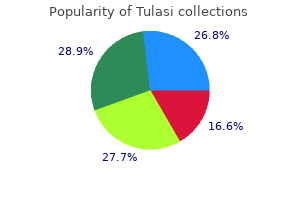
Purchase tulasi line
Studies in nonrenal transplant recipients have yielded conflicting outcomes as to which is more nephrotoxic. Control of hypertension per se is probably more essential than use of any particular antihypertensive agent. This is an area of ongoing debate in liver and, to a lesser extent, cardiac transplantation and is discussed in detail later. The basic advantages and disadvantages of simultaneous dual-organ transplantation are shown in Table 111-1. This displays the perceived technical difficulties of performing the procedure in critically ill-often coagulopathic-patients, in whom a biopsy-related bleed could have catastrophic consequences. Indeed, these complications could be more extreme in nonrenal transplant recipients because of different risk elements. For example, antiproliferative immunosuppressants exacerbate anemia and corticosteroids exacerbate metabolic bone disease. The preliminary evaluation ought to embrace thorough evaluation of renal operate in the peritransplantation period and publicity to nephrotoxins. Finally, some have advocated switching of cyclosporine to low-dose tacrolimus, although the supporting data are less compelling. Thus, hypertension, anemia, and hyperparathyroidism must be managed based on normal pointers. In apply, lifestyle modification and a quantity of other antihypertensive medicine are often required for achievement of target blood pressure. With either modality, mortality is much higher compared with matched nontransplant controls. There appears little doubt that in these fit for the process, sequential kidney transplantation is the best form of renal replacement therapy. Initial mortality is larger in nonrenal transplant recipients receiving a kidney transplant versus staying on the ready list (reflecting the issues of surgical procedure and more immunosuppression), but mortality in the medium and long run is much decrease. Severe rhabdomyolysis has been reported, often when statins are prescribed with cyclosporine and an inhibitor of the cytochrome P-450 system, such as diltiazem or ketoconazole and other azole-based antifungal brokers. The number and percentage of simultaneous liver-kidney transplants have elevated tremendously in the United States in current years. The main issue, of course, is deciding which sufferers are prone to have significant renal recovery after liver transplant alone. Singlecenter studies counsel that use of a mix of medical and histologic standards allows efficient prediction of which patients will benefit most from simultaneous liver-kidney transplantation. Renal biopsy was carried out by the percutaneous or transjugular technique and had a reasonable fee of complications21,22; some imagine that it provides little discriminating worth. In the largest reported study, 1% of heart transplant recipients required renal replacement therapy earlier than transplantation. Ventricular assist units are generally used as a bridge to cardiac transplantation and can enhance renal function in this setting. In some sufferers there may also be a component of persistent kidney injury caused by renovascular disease or hypertension or atheroembolism. In addition to the causes proven in Table 111-2, components that could be necessary after cardiac transplant surgery are extended aortic cross-clamping, large fluid quantity shifts, and extended allograft ventricular dysfunction. As in liver transplantation, the query of whether or not the patient is finest served by heart-alone or simultaneous heart and kidney transplantation generally arises. The absolute number of such twin transplants remains low however is steadily rising in the United States (71 in 2012, equal to about three. At this time, it seems affordable to restrict the mixed transplants to patients with no less than a severity of kidney illness just like that shown in Box 111-1. First, aggressive diuresis is usually prescribed to minimize any pulmonary edema within the allograft. The most encouraging therapy to date is defibrotide, an oligonucleotide with antithrombotic and fibrinolytic results on microvascular endothelium, but with apparently few systemic antagonistic results. These embrace prerenal syndromes caused by hepatorenal syndrome (see later) and hypovolemia (induced by vomiting and diarrhea or bleeding). Obstructive uropathy is way rarer but may be attributable to severe hemorrhagic cystitis or fungal an infection of the collecting system.
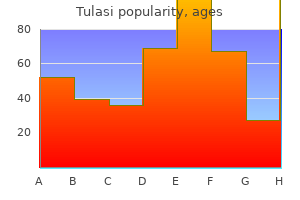
Discount tulasi 60 caps otc
Studies recommend that immunosuppressive agents have different effects on cancer danger after transplantation. Both preclinical and scientific research have demonstrated that sirolimus and everolimus have antiproliferative and antitumoral results. Donor-derived fungal infections in organ transplant recipients: Guidelines of the American Society of Transplantation, infectious ailments neighborhood of apply. The Banff 2009 working proposal for polyomavirus nephropathy: A critical evaluation of its utility as a determinant of medical outcome. Treatment of polyomavirus infection in kidney transplant recipients: A systematic evaluation. Gastrointestinal high quality of life enchancment of renal transplant recipients transformed from mycophenolate mofetil to enteric-coated mycophenolate sodium drugs or brokers: Mycophenolate mofetil and enteric-coated mycophenolate sodium. Evaluation of potential interplay between mycophenolic acid derivatives and proton pump inhibitors. Incidence of main and second cancers in renal transplant recipients: A multicenter cohort research. Prostate most cancers previous to solid organ transplantation: the Israel Penn International Transplant Tumor Registry experience. Managing post-transplant lymphoproliferative disorders in solid-organ transplant recipients. Effect of cyclosporine and tacrolimus on the expansion of Epstein-Barr virus�transformed B-cell strains. The use of immunosuppression on posttransplant lymphoproliferative illness in pediatric liver transplant sufferers. Rapamycin inhibits the interleukin 10 transduction pathway and the expansion of Epstein-Barr virus B cell lymphomas. The study also demonstrated that the earlier the conversion after an preliminary diagnosis of cutaneous squamous cell carcinoma, the greater efficacy. Sirolimus remedy has also been reported to result in profitable medical and histologic remission of Kaposi sarcoma in kidney transplant recipients. Nonetheless, sirolimus has increasingly been used in the secondary prevention of pores and skin cancer. It is our present practice to start patients with newly recognized pores and skin most cancers (or those with a historical past of skin cancer) on sirolimus or everolimus along side discount or discontinuation of other immunosuppressants. Influenza vaccination within the organ transplant recipients: Review and Summary suggestions. International Valacyclovir Cytomegalovirus Prophylaxis Transplantation Study Group. Transplantation Society International Consensus Group: International consensus pointers on the administration of cytomegalovirus in solid organ transplantation. Updated International Consensus Guidelines on the management of cytomegalovirus in solid-organ transplantation. Association of immunosuppressive maintenance regimens with posttransplant lymphoproliferative dysfunction in kidney transplant recipients. Racial variation in the improvement of posttransplant lymphoproliferative issues after renal transplantation. Posttransplant lymphoproliferative issues after renal transplantation within the United States in period of recent immunosuppression. Aggressive posttransplant lymphoproliferative disease in a renal transplant affected person treated with alemtuzumab. Association between liver transplantation for Langerhans cell histiocytosis, rejection, and development of posttransplant lymphoproliferative disease in kids. Hepatitis C virus infection and threat of posttransplant lymphoproliferative dysfunction amongst strong organ transplant recipients. Using Epstein-Barr viral load to diagnose, monitor, and diagnose post-transplant lymphoproliferative disorder. Organ transplant recipients and skin most cancers: Assessment of threat factors with focus on solar publicity. Sirolimus and non-melanoma pores and skin most cancers prevention after kidney transplantation: A meta-analysis.
Syndromes
- Peritonsillar abscess
- Your sleeping problem occurs more than 3 nights per week for more than 1 month
- Muscles becoming smaller (atrophy)
- Cardiac index is 2.8 to 4.2 liters per minute per square meter (of body surface area)
- Skin conductivity of electricity
- Abnormal reflexes
- Total lung capacity (TLC)
- Wipe off stingers or tentacles with a towel.
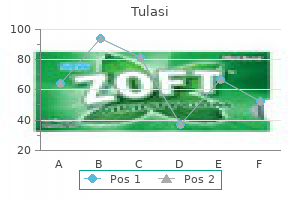
Best order for tulasi
It is usually a results of poor bladder perform and requires drainage with a bladder catheter for 5 to 7 days and assessment of bladder dysfunction. A urethritis dysuria syndrome occurs in 2% to 8% of pancreas recipients with bladder drainage and is attributable to uroepithelial publicity to the activated pancreatic proenzymes trypsinogen, chymotrypsinogen, and procarboxypeptidase. Pancreatic exocrine secretions encompass bicarbonate, amylase, lipase, and proenzymes, that are activated by the enterokinase within the graft duodenal brush border. Increased intravesical enzyme activation happens with lowgrade urinary infections and urinary stasis, and sufferers will develop voiding ache or penile, glandular, meatal, or vulval ulceration. Enzyme activation may be minimized by therapy of low-count bacteriuria, increase in fluid intake, and frequent voiding. Retrograde urethrography Detrusor dysfunction or bladder outlet obstruction Urethral stricture or disruption Enteric Conversion Treat with urethral (Foley) catheter Treat with -adrenoceptor blockers or transurethral resection of the bladder neck (males) Enteric conversion is an possibility for a lot of the continual urologic complications associated with bladder-drained pancreas transplantation. The indications are urethral disruption, recurrent urine leak, persistent bleeding, chronic urinary tract infection, dysuria, recurrent hypovolemia, and metabolic acidosis. It is ideal to wait until 6 to 12 months after transplantation, when possible, to allow monitoring of urine amylase for early rejection episodes. There could be an acute presentation of graft rejection, not completely different from that seen in early graft dysfunction. Hyperglycemia secondary to rejection is a late event and indicates irreversible graft damage. Patients remain at danger of retinal detachment due to scarring secondary to earlier retinal damage. Sensory and motor nerve conduction velocities improve quickly after pancreas transplantation after which stabilize. Early diabetic nephropathy is characterised by elevated glomerular basement membrane thickness and a rise in mesangial volume. Wellfunctioning pancreas transplants lead to normal fasting blood glucose concentrations, regular glycated hemoglobin ranges, and solely slightly abnormal oral glucose tolerance testing outcomes. They are related to high-carbohydrate meals, excessive intake of caffeine or alcohol, excessive train, and, in some patients with hypoglycemia, circulating anti-insulin antibodies. A major good thing about pancreas transplantation is restoration of glucagon secretory responses to hypoglycemia. In type 1 diabetics, the absence of useful beta cells throughout the islet eliminates the traditional physiologic response by which intra-islet insulin tonically dampens secretion of glucagon from alpha cells. After pancreas transplantation, hypoglycemic consciousness returns, as nicely as partial return of defective epinephrine secretion throughout insulin-induced hypoglycemia. Nephropathy Hyperglycemia Post-transplantation hyperglycemia could also be brought on by pancreas graft dysfunction, inadequate insulin launch secondary to high tacrolimus or sometimes cyclosporine levels, resistance to insulin secondary to corticosteroids, weight achieve, and inadequate bodily exercise. Although using tacrolimus has decreased pancreas graft rejection, it additionally decreases insulin gene transcription. If laboratory and imaging evaluations (see Table 110-1) are regular, hyperglycemia is the outcomes of decreased insulin manufacturing or else of peripheral insulin resistance, which could be recognized by measurement of glucose usage rates and glucose/arginine-potentiated insulin secretion. In the absence of graft rejection, post-transplantation hyperglycemia should first be managed by dietary intervention and exercise. Insulin may be needed initially but can often be discontinued as oral hypoglycemic agents Vascular Disease Successful kidney-pancreas transplantation results in a big improvement within the management of hypertension compared with kidney transplant alone in kind 1 diabetics. The first collection of islet allotransplantations in type 1 diabetic patients have been reported in 1977. Pretransplantation debilities (decreased imaginative and prescient, neuropathy, muscle weak point, orthostatic symptoms) can be exacerbated by the surgical procedure and immunosuppressive medicines. The new child outcomes were prematurity (39 of 50), low delivery weight (32 of 50), other neonatal problems (28 of 50), and neonatal death (1 of 50). Ten sufferers had rejections that resulted in grafts loss, and 58% of the patients required cesarean part. Hypertension, prematurity, preeclampsia, and progress retardation frequently complicated the pregnancies, even with good renal perform. Consensus opinion is that being pregnant is safe by 1 yr after transplantation underneath the next circumstances: no rejection has occurred up to now 12 months, graft operate is steady, no active infections that might have a negative impression on the fetus. The average gestational period is 35 � 2 weeks; the average start weight is 2150 � 680 g. However, there might be destabilization of the transplanted kidney and in addition islet dysfunction because most kidney transplant immunosuppression protocols included corticosteroids.
Buy 60 caps tulasi with mastercard
Hypoxia Chronic ingestion of alcohol ends in increased oxygen demand by the liver leading to a hypoxic state which causes hepatocellular necrosis in centrilobular zone (zone 3). Increased liver fats the origin of fat in the body was discussed in Chapter 2 (page 19). Fat cysts might develop because of coalescence and rupture of fat-containing hepatocytes. Less often, lipogranulomas consisting of collection of lymphocytes, macrophages and a few multinucleate large cells may be discovered. There is diffuse nodularity (nodules less than 3 mm diameter) on sectioned surface of the liver. The nodules of the liver because of their fats content material are tawny-yellow, on the basis of which Laennec in 1818 introduced the time period cirrhosis to begin with (from Greek kirrhos = tawny). The laboratory findings in the midst of alcoholic liver illness may be quite variable and liver biopsy is critical in doubtful cases. Progressive type of the illness, however, typically presents the following biochemical and haematological alterations: 1. Post-necrotic Cirrhosis Post-necrotic cirrhosis, also termed post-hepatitic cirrhosis, macronodular cirrhosis and coarsely nodular cirrhosis, is characterised by massive and irregular nodules with broad bands of connective tissue and occurring mostly after previous viral hepatitis. Viral hepatitis About 25% of sufferers give historical past of current or distant assaults of acute viral hepatitis adopted by continual viral hepatitis. Drugs and chemical hepatotoxins A small percentage of cases could have origin from toxicity as a end result of chemical substances and drugs similar to phosphorus, carbon tetrachloride, mushroom poisoning, acetaminophen and -methyl dopa. Idiopathic After all these causes have been excluded, a bunch of instances stay in which the etiology is unknown. Grossly, the liver is usually small, weighing lower than 1 kg, having distorted shape with irregular and coarse scars and nodules of various size. Sectioned surface shows scars and nodules varying in diameter from 3 mm to a few centimeters. The results of haematologic and liver perform check are just like those of alcoholic cirrhosis. Out of the assorted forms of cirrhosis, postnecrotic cirrhosis, especially when associated to hepatitis B and C virus an infection in early life, is extra regularly related to growth of hepatocellular carcinoma later. Primary biliary cirrhosis in which the destructive means of unknown etiology impacts intrahepatic bile ducts. Secondary biliary cirrhosis ensuing from extended mechanical obstruction of the extrahepatic biliary passages. However, presently probably the most broadly accepted hypothesis is autoimmune origin of the disease. Secondary biliary cirrhosis Most cases of secondary biliary cirrhosis result from prolonged obstruction of extrahepatic biliary passages (page 584). Fibrous septa dividing the hepatic parenchyma into nodules are thick and comprise outstanding mononuclear inflammatory cell infiltrate and bile ductular hyperplasia. Although etiology stays unknown, numerous mechanisms have been postulated which include viral and bacterial infections, immunologic harm, toxins, and genetic predisposition. Microscopically, the options of intra- and extrahepatic cholestasis correspond to main and secondary biliary cirrhosis respectively mentioned on page 584. The disease evolves by way of the next four histologic states: Stage I: There are florid bile duct lesions confined to portal tracts. Bile stasis, degeneration and focal areas of centrilobular necrosis of hepatocytes. Fibrosing cholangitis with lymphocytic infiltrate around bile ducts with segmental involvement. The analysis of secondary biliary cirrhosis is taken into account in patients with earlier historical past of gallstones, biliary tract surgical procedure or scientific features of ascending cholangitis. The disease occurs in third to 5th decade of life with two fold preponderance in males. Idiopathic (primary, genetic) haemochromatosis is an autosomal recessive dysfunction of excessive accumulation of iron. In haemochromatosis, however, this quantity goes up to four mg/day or more, as evidenced by elevated serum iron (normal about one hundred twenty five mg/dl) and elevated serum transferrin saturation (normal 30%).
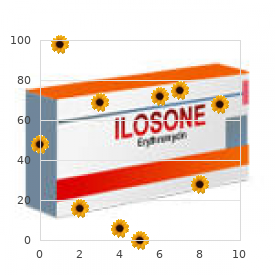
60caps tulasi order fast delivery
Oligodendroglioma Oligodendroglioma is an unusual glioma of oligodendroglial origin and should develop in isolation or could also be mixed with different glial cells. Oligodendrogliomas sometimes have deletions and translocations affecting chromosomes 1p and 19q, which have both diagnostic and prognostic worth. Microscopically, the tumour is characterised by uniform cells with round to oval nuclei surrounded by a clear halo of cytoplasm and well-defined cell membranes. Clinically, by virtue of their frequent location in the flooring of the fourth ventricle, ependymomas are related to obstructive hydrocephalus. Myxopapillary ependymoma It is a special variant of ependymoma which is frequent and happens in adults. True to its name, it incorporates myxoid and papillary structures interspersed in the typical ependymal cells. Subependymoma It happens as a small, asymptomatic, incidental strong nodule in the fourth and lateral ventricle of middle-aged or elderly sufferers. They are invariably benign tumours and rarely ever endure malignant transformation. Microscopically, medulloblastoma is composed of small, poorly-differentiated cells with ill-defined cytoplasmic processes and tends to be arranged around blood vessels and infrequently forms pseudorosettes (HomerWright rosettes). Another characteristic of the tumour is differentiation into glial or neuronal parts. It could happen sporadically or be part of von Hippel-Lindau syndrome (along with cysts within the liver, kidney, and benign/ malignant renal tumour). Thus, about a quarter haemangioblastomas secrete erythropoietin and trigger polycythaemia. Germ Cell Tumours Rarely, germ cell tumours might happen within the brain, especially in children. They are normally present in 2nd to 6th a long time of life, with slight female preponderance. The tumour is mostly firmly connected to the dura and indents the floor of the mind however hardly ever ever invades it. The tumour consists of strong lots of polygonal cells with poorly-defined cell membranes. The cells have round to oval, central nuclei with plentiful, finely granular cytoplasm. Some quantity of collagenous stroma is current that divides the tumour into irregular lobules. Fibrous (fibroblastic) meningioma A much less frequent sample is of a spindle-shaped fibroblastic tumour during which the tumour cells kind parallel or interlacing bundles. Transitional (mixed) meningioma this sample is characterised by a mixture of cells with syncytial and fibroblastic options with conspicuous whorled sample of tumour cells, usually round central capillary-sized blood vessels. Some of the whorls comprise psammoma our bodies due to calcification of the central core of whorls. Other types of degenerative adjustments like xanthomatous and myxomatous degeneration may also be encountered, in transitional selection. Angioblastic meningioma An angioblastic meningioma consists of 2 patterns: haemangioblastic sample resembling haemangioblastoma of the cerebellum, and haemangiopericytic sample which is indistinguishable from haemangiopericytoma elsewhere within the physique. This pattern of meningioma is related to extraneural metastases, primarily to the lungs. Myelinated axons have their origin from neurons within the posterior root ganglia and the anterior horn cell of the spinal wire, whereas non-myelinated axons arise from neurons within the posterior root ganglia and within the autonomic ganglia. Oligodendroglioma is an uncommon glioma of oligodendroglial origin and should develop in isolation or could also be mixed with other glial cells. Ependymoma is derived from the layer of epithelium that lines the ventricles and the central canal of the spinal cord. Medulloblastoma is the most typical primitive neuroectodermal tumour occurring in children. Approximately 1 / 4 of intracranial tumours are metastatic tumours, usually from carcinomas. The peripheral nerves, in distinction to brain, have regenerative capability as has been mentioned on page 156. However, if the method of regeneration is hampered due to an interposed haematoma or fibrous scar, the axonal sprouts together with Schwann cells and fibroblasts form a peripheral mass called as traumatic or stump neuroma.

Purchase tulasi with a mastercard
Besides local effects, acute inflammation produces systemic manifestations similar to fever, leucocytosis, lymphangitis and shock. Acute inflammation may have variety of outcomes: resolution, therapeutic (by regeneration or by fibrosis), suppuration or may find yourself in chronic irritation. Recurrent attacks of acute irritation When repeated bouts of acute inflammation culminate in chronicity of the method. Chronic inflammation starting de novo When the an infection with organisms of low pathogenicity is persistent from the beginning. The blood monocytes on reaching the extravascular space transform into tissue macrophages. A few general features of chronic irritation are infiltration by mononuclear cells, tissue destruction and proliferation of blood vessels and fibroblasts. It is a protective protection reaction by the host however ultimately causes tissue destruction due to persistence of the poorly digestible antigen. Multinucleate giant cells Multinucleate large cells are shaped by fusion of adjacent epithelioid cells and will have 20 or extra nuclei. The former are commonly seen in tuberculosis whereas the latter are common in overseas body tissue reactions. Like epithelioid cells, these giant cells are weakly phagocytic however produce secretory products which assist in removing the invading agents. Lymphoid cells As a cell-mediated immune response to antigen, the host response by lymphocytes is integral to composition of a granuloma. Fibrosis Fibrosis is a characteristic of healing by proliferating fibroblasts at the periphery of granuloma. The classical instance of granulomatous irritation is the tissue response to tubercle bacilli which is identified as tubercle seen in tuberculosis (described later). Major variations between acute and chronic irritation are summed up in Table 5. Epithelioid cells these are so called because of their epithelial cell-like appearance. They are modified macrophages/histiocytes that are somewhat elongated cells having slipper-shaped nucleus. Systemic Effects Present � Fever:highgrade � Leucocytosis(neutropphilic,eosinophilic) � Lymphadenitis-lymphangiitis � Septicshock(insevereacuteinfection) 7. Main morphology � Abscesses(suppuration) � Ulcers � hroughblood(Bacteraemia,septicaemia, T pyaemia) � Resolution � Healing(regeneration,fibrosis) � Chronicity Pyogenic abscess, cellulitis, bacterial pneumonia, pyaemia 8. Granulomatous ailments embody infections (bacterial, fungal, parasitic) autoimmune inflammatory, and foreign bodies. In fact, half the whole number of instances in the world are shared by India and China. Observations in several populations recommend that in addition to these elements, genetic factors also play a key position in innate resistance to infection with M. Cervicofacial, stomach and thoracic lesions; granulomas and abscesses with draining sinuses; sulphur granules. Eggs and granulomas in gut, liver, lung; schistosome pigment; eosinophils in blood and tissue. Non-caseating granulomas (hard tubercles); asteroid and Schaumann our bodies in large cells. Transmural chronic inflammatory infiltrates; non-caseating sarcoid-like granulomas. Sarcoid-like granulomas in lungs; fibrosis; inclusions in large cells (asteroids, Schaumann our bodies, crystals). Non-caseating granulomas with international body large cells; demonstration of foreign body. Out of assorted pathogenic strains for human disease included in Mycobacterium tuberculosis complicated, currently the most common is M. It takes up stain by heated carbol fuchsin and resists decolourisation by acids and alcohols (acid quick and alcohol fast) and can be decolourised by 20% sulphuric acid (compared to 5% sulphuric acid for decolourisation for M. This methodology is quite dependable and employs use of fluorescent dyes such as auramine and rhodamine.
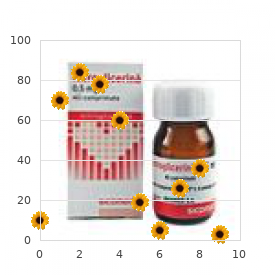
60caps tulasi with mastercard
On the opposite hand, there are true vascular tumours which are of intermediate grade and there are frank malignant tumours. A classification of vascular tumours and tumour-like circumstances is given in Table thirteen. Clinically, they seem as small or giant, flat or slightly elevated, purple to purple, gentle and lobulated lesions, varying in measurement from a few millimeters to a few centimeters in diameter. The vascular areas are large, dilated, many containing blood, and are lined by flattened endothelial cells. Histologically, it reveals proliferating capillaries similar to capillary haemangioma but the capillaries are separated by ample oedema and inflammatory infiltrate, thus resembling inflammatory granulation tissue. It is a small, circumscribed, slightly elevated lesion measuring 1 to 2 cm in diameter. These lesions, although benign, are often difficult to remove as a outcome of infiltration into adjoining tissues. Histologically, the tumours are composed of small blood vessels lined by endothelium and surrounded by aggregates, nests and masses of glomus cells. The intervening connective tissue stroma accommodates some nonmyelinated nerve fibres. Most common website of involvement is the pores and skin and bones whereas a closely related condition peliosis hepatis is seen in the liver (page 589). Histologically, lobules of proliferating blood vessels are seen lined by epithelioid endothelial cells having delicate atypia. Mixed inflammatory cell infiltrate with nuclear particles of neutrophils is present in these areas. Large cystic spaces lined by the flattened endothelial cells and containing lymph are current. There are blood-filled vascular channels lined by endothelial cells and surrounded by nests and masses of glomus cells. Reticulin stain delineates the sample of cell proliferation inner to the basement membrane. This is a rare tumour that may happen at any website but is more frequent in lower extremities and the retroperitoneum. A, the vascular channels are lined by multiple layers of plump endothelial cells having minimal mitotic activity obliterating the lumina. B, Reticulin stain exhibits condensation of reticulin across the vessel wall however not between the proliferating cells. Spindled cells surround the vascular lumina in a whorled fashion, highlighted by reticulin stain. The Blood Vessels and Lymphatics Local recurrences are common and distant unfold occurs in about 20% of instances. It is present in younger age, particularly in boys and in young males and has a more aggressive course than the classic kind. The lesions could additionally be localised to the pores and skin or could have widespread systemic involvement. Early patch stage There are irregular vascular spaces separated by interstitial inflammatory cells and extravasated blood and haemosiderin. Haemangioendothelioma is a real tumour of endothelial cells, having an intermediate behaviour. Transverse lines divide each fibre into sarcomeres which act as structural and useful subunits. The conduction system of the center situated within the myocardium is liable for regulating fee and rhythm of the guts. It consists of specialised Purkinje fibres which include some contractile myofilaments and conduct action potentials quickly. The endocardium is the graceful shiny inner lining of the myocardium that covers all of the cardiac chambers, the cardiac valves, the chordae tendineae and the papillary muscle tissue. It is lined by endothelium with connective tissue and elastic fibres in its deeper part. Myocardial Blood Supply Systemic Pathology the cardiac muscle, so as to operate correctly, should receive adequate supply of oxygen and vitamins. There are 3 anatomic patterns of distribution of the coronary blood supply, relying upon which coronary artery crosses the crux. Crux is the region on the posterior surface of the heart the place all of the four cardiac chambers and the interatrial and interventricular septa meet.
Real Experiences: Customer Reviews on Tulasi
Ketil, 38 years: Ultimately, malignant tumours develop in size as a outcome of the cell production exceeds the cell loss.
Gorok, 60 years: Pathogenetically, apoptosis is triggered by loss of alerts of normal cell survival and by action of agents injurious to the cell.
Sobota, 35 years: The hypercalcemia of hyperparathyroidism is associated sometimes with basic parathyroid bone illness and nephrolithiasis.
Vibald, 62 years: For recalcitrant delirium, Quetiapine 25 to 50 mg at bedtime has been proven to be an efficient adjunct (J Hosp Med.
Wilson, 57 years: Mutations in membrane proteins-a-spectrin, b-spectrin and ankyrin, result in defect in anchoring of lipid bilayer of the membrane to the underlying cytoskeleton.
Saturas, 37 years: Yesterday he had a small quantity of blood from his tracheostomy which stopped spontaneously.
9 of 10 - Review by T. Agenak
Votes: 30 votes
Total customer reviews: 30
References
- Yokoyama S, Woods SL, Boyle GM, et al: A novel recurrent mutation in MITF predisposes to familial and sporadic melanoma, Nature 480(7375):99n103, 2011.
- Mego M, Chovanec J, Vochyanova-Andrezalova I, et al. Prevention of irinotecan induced diarrhea by probiotics: a randomized double blind, placebo controlled pilot study. Complement Ther Med 2015;23(3):356-362.
- Orenstein A, Masur H. A diagnostic approach to Pneumocystis jiroveci pneumonia. In: Maertens JA, Marr KA, eds. Diagnosis of Fungal Infections. New York: Informa Heathcare; 2007:267-290.
- Atala A, Lailas NG, Cilento BG, et al: Progressive ureteral dilation for subsequent ureterocystoplasty. Presented at: Section on Urology meeting, American Academy of Pediatrics. Dallas, TX, 1994.
- Cucurull E, Espinoza L: Gonococcal arthritis. Rheum Dis Clin North Am 24:305-322, 1998.
